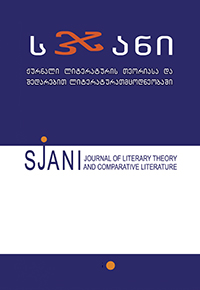Expansion, Exclusion and Recurrence between ‘Art as a
Means for Salvation’ and ‘History as a Creation of Art’:
Dmitry Merezhkovsky and His Close Com
Expansion, Exclusion and Recurrence between ‘Art as a
Means for Salvation’ and ‘History as a Creation of Art’:
Dmitry Merezhkovsky and His Close Com
Author(s): Yordan LyutskanovSubject(s): Literary Texts
Published by: ლიტერატურის ინსტიტუტის გამომცემლობა
Keywords: D. Merezhkovsky; “Eternal Companions”; E. Auerbach; philosophy of history; neoclassicism, Joachism; Byzantinism
Summary/Abstract: In this paper I shall investigate Dmitry Merezhkovsky’s conceiving of history, the constraints and possibilities it imposes. Pointing at some of his predecessors and successors, I will try to attain a position interoperable with both typology and genetic survey. Departing from examination of Russian history of ideas, I will try to approach the issue of German-Russian intellectual exchange. Dmitry Merezhkovsky (1865–1941) is among the founders of modernism in Russia and may be the most prominent ideologist of Russian modernism (which he propagates as a cultural and outlook style, not only as an art technique). He charged Russian modernism with the task of forerunning Russian Renaissance and Russian Reformation (Lutskanov 2011a) and after a decade in the cultural avant-garde he drifted from modernists in art to preserve fidelity to his idea of Reformation. His radicalism, however, was underlined by a considerable conservatism; and his futurism was fed by – or had produced in order to have a firm ground to stay on – a pious yet high-handed vision of tradition. (This ambivalent attitude to tradition was wittily characterised already by Evgeny Lundberg. (1914: 1 ff.)1 Merezhkovsky observes the tradition from an elevated position: the series of innumerable facts produced by positivist scholarship are displaced by a discernible pattern of countable elements and configurations – but without descend to a school anthology. (However, the anthologising tendency of Merezhkovsky’s literary-historical vision is testified by the fate of his work best to embody the lyricisation of history’s structure just defined: his wife remembered that in the last years preceding the 1914 war „Eternal Companions“* („Вечные спутники“, 1897) was very popular and secondary schools’ graduates were awarded copies of the book (Gippius 1990: 350)). Tradition is perceived as a whole which could – at least in imagination – be visually measured and even embraced. Merezhkovsky constitutes himself as staying at the end of an epoch, or, rather, of different in scope epochs: of Russian classical literature, of the teaching of classical languages at school, of what some scholars called „reflective traditionalism“. In the short run of early Russian modernism he is a classic (followed by mannerists); yet in the long run of European tradition he is an epigone (I invest no evaluation at all in this word). I continue my discussion (Lutskanov 2010: 197–200; Lyutskanov 2011b) of Merezhkovsky’s aesthetical and what might be called „geo-sophical“ conservatism distinguishable in his second book of literary criticism, „Eternal Companions“ (essays from 1888 – 1896, issued 18972). The book seems to embody intent to combine cognition and form creation; it contributes to a hybrid discipline definable as „historiosophy of and through literature“. Regarding the book as a textual whole3, I focused on its ideology and on what could be called its „aesthetic subconscious“ (though
Journal: სჯანი
- Issue Year: 2011
- Issue No: 12
- Page Range: 162-179
- Page Count: 18
- Language: English

